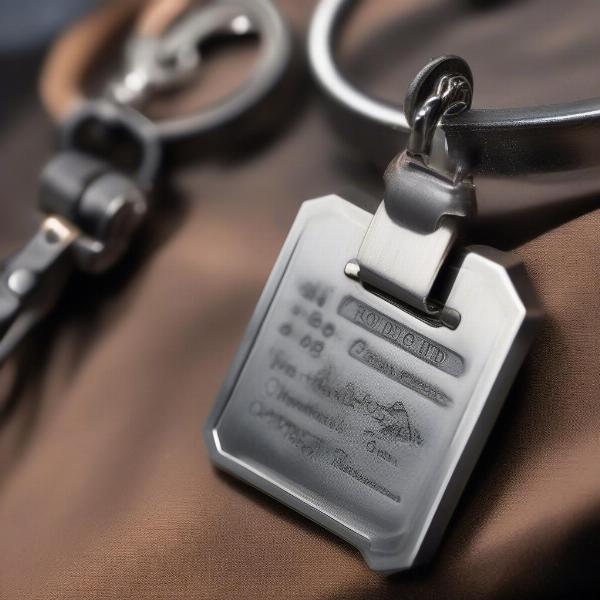Dog ID tag holders are a seemingly small detail, but they play a vital role in your dog’s safety. A lost dog with proper identification has a much higher chance of being reunited with their owner. This guide will explore the different types of dog ID tag holders, helping you choose the perfect one to keep your furry friend safe and sound.
Types of Dog ID Tag Holders: Finding the Right Fit for Your Pup
Dog ID tag holders come in a wide range of styles and materials. Understanding the pros and cons of each can help you make an informed decision. Metal holders are durable and long-lasting, often made from stainless steel or aluminum. They can be engraved with your dog’s information, offering a permanent identification solution. Leather holders provide a more classic and stylish look. They are typically quieter than metal tags, reducing the jingle as your dog moves. Plastic holders are a lightweight and affordable option, coming in a vast array of colors and designs. However, they are less durable than metal or leather.
Material Matters: Durability and Style Combined
The material of your chosen dog ID tag holder affects both its durability and aesthetic appeal. What works for a small, pampered chihuahua might not be suitable for a large, adventurous Labrador.
Metal ID Tag Holders: Strength and Longevity
 Close Up of Durable Metal Dog ID Tag Holders
Close Up of Durable Metal Dog ID Tag Holders
Metal ID tag holders are known for their strength and resistance to wear and tear. Stainless steel is a popular choice for its corrosion resistance and hypoallergenic properties, making it ideal for dogs with sensitive skin. Aluminum is another good option – it’s lightweight yet strong.
Leather ID Tag Holders: Classic Elegance
Leather offers a timeless and sophisticated look. It’s also relatively quiet, minimizing the jingling sound often associated with metal tags. However, leather is less durable than metal and can be susceptible to damage from water or chewing.
Plastic ID Tag Holders: Affordability and Variety
Plastic ID tag holders are the most budget-friendly option. They come in a wide array of colors and designs, allowing you to personalize your dog’s identification. However, plastic is less durable and can break more easily than metal or leather.
Attachment Methods: Keeping the Tags Secure
The way the tag holder attaches to your dog’s collar is just as important as the holder itself. Split rings are the most common and affordable option, but they can sometimes become unfastened. S-hooks offer a more secure connection but can be slightly bulkier. Some holders are riveted directly onto the collar, offering the most secure attachment, but this requires a specific type of collar.
What Information to Include on Your Dog’s ID Tag
Ensuring your dog’s ID tag contains the correct information is paramount. Include your dog’s name, your phone number, and your city and state. Consider adding your address or email address, though some owners prefer to omit this information for privacy reasons. A microchip is an additional layer of security, providing a permanent form of identification.
Choosing the Right Size and Shape
The size and shape of the ID tag should be appropriate for your dog’s size and breed. A large, heavy tag might be uncomfortable for a small dog, while a tiny tag might be easily lost on a large dog. Consider your dog’s lifestyle and activity level when choosing the shape and size of the tag.
Frequently Asked Questions
- What is the best material for a dog ID tag holder? The best material depends on your dog’s size, lifestyle, and your personal preferences. Metal is the most durable, leather is stylish and quiet, and plastic is affordable and comes in many designs.
- What information should be on my dog’s ID tag? Your dog’s name, your phone number, and your city and state are essential.
- How do I attach the ID tag to my dog’s collar? Most ID tags attach using split rings or s-hooks.
- What if my dog loses their ID tag? Consider microchipping your dog as a backup form of identification.
- Are personalized ID tags a good idea? Yes, personalized tags can add a touch of personality and make it easier for someone to contact you if your dog gets lost.
- How often should I replace my dog’s ID tag? Replace the tag if it becomes worn, illegible, or the information is outdated.
- Can I put my dog’s medical information on their ID tag? While it’s helpful, it’s best to prioritize essential contact information due to space limitations.
Conclusion
Choosing the right dog ID tag holder is a crucial step in ensuring your dog’s safety. By considering the material, attachment method, and information included, you can provide your furry friend with the best possible chance of being returned home safely should they ever get lost. Investing in a durable and well-designed dog ID tag holder is a small price to pay for the peace of mind it provides.
About ILM Dog: ILM Dog is your one-stop resource for expert advice on all aspects of dog care, from breed selection and puppy care to senior dog health and training. We offer practical tips and insights to help you provide the best possible care for your canine companion. For any questions or inquiries, contact us at [email protected] or +44 20-3965-8624.